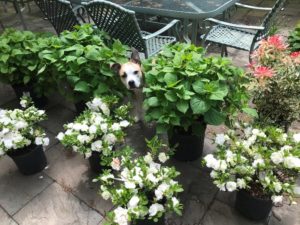Latest Posts
- Have a purpose when backyardingAugust 5 2021
- Study: Time outside alters our microbiomeAugust 4 2021
- Happy National Mutt Day from Mo-MoJuly 27 2021
- New home? Avoid these common mistakes in your yard.July 26 2021
- Infographic: Plan a backyard staycation this summerJuly 22 2021
Categories
Archive
July 26th
New home? Avoid these common mistakes in your yard.
Millions of Americans moved during the pandemic – many to homes with bigger yards for outdoor living. The trend of spending more time in the family yard – a.k.a. “backyarding” – is good for our health and well-being, and it creates a safe place to make memories with family and friends.
Here is some yard care advice for buyers who are settling into a new home this summer.
Choose the right plants. Do you live in a climate with long, hot summers? Are you in an arid region or a wet one? Understanding the environment will help you select climate-appropriate plants that will thrive with minimal input. Check out the USDA Plant Hardiness Zone Map to learn which plants, grasses, shrubs and trees are most likely to succeed in your location. Remember: right plant, right place.
Consider your lifestyle needs. When selecting and placing your living landscapes, consider your lifestyle needs. Do you want to care for your lawn yourself or will you hire landscaping help? Do you have children and/or pets that need a large area of sturdy turfgrass for running and playing? Remember, plants can be used strategically to designate “activity zones” in the yard – separating a children’s play area from the dining space, for example.
Don’t forget pollinators & wildlife. Living landscapes are vital to pollinators (bees, butterflies and birds) and other backyard wildlife who rely on the plants in the backyard ecosystem for food and shelter. Planting nectar and pollen-rich flowers that are appropriate for your climate (see above) will help nourish pollinators. Also take note of migrating birds and insects – you might be in a migrating pathway. If so, choose plants and flowers that benefit them. Using a mulch mower and let grass clippings decompose on the lawn to provide nitrogen to the soil and shelter insects and worms.
Water properly. Plants will grow stronger and work harder – creating deeper, healthier roots – if they have to work to find water. Watering deeply, but less frequently, allows moisture to reach the roots of the grass and trees in your yard. Watering early in the morning reduces excess evaporation while installing soil moisture sensors and drip irrigation systems can take the guesswork out of watering.
Have the right equipment for your outdoor space. Going from an apartment to a single-family home for the first time? You might need new lawn care equipment. Make sure your lawn mower is the right size for your new yard, and upgrade if needed. If the lot at your new property is wooded, a chainsaw and/or hedge trimmer may be required. Today’s equipment is designed to suit every yard and in a variety of power sources, including battery/electric, gasoline, propane, solar and more.
Cut the grass to the right height. Proper mowing helps create a lower-maintenance, drought-tolerant lawn. The perfect length varies by grass type, but the general rule of thumb is to cut only the top third of the grass blades off at any given time. Taller grass blades shade the soil and keep it cooler, helping control weeds. Taller grass is also softer to walk on – important for little feet and paws.
To learn more, go to TurfMutt.com.






